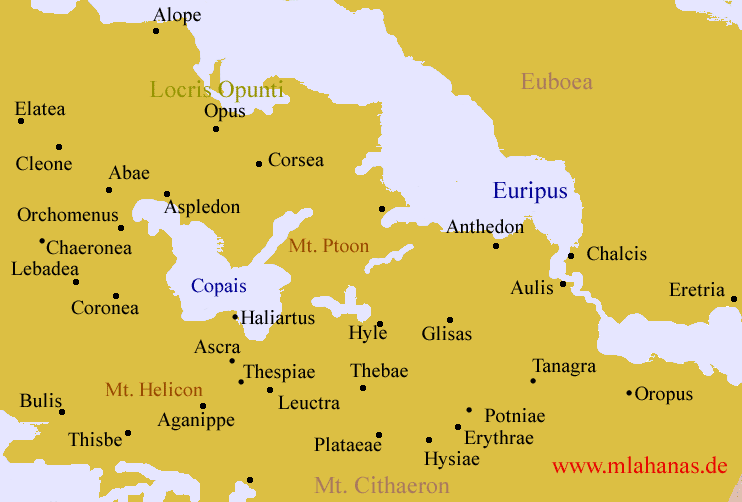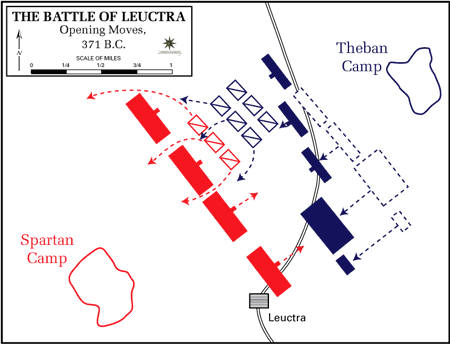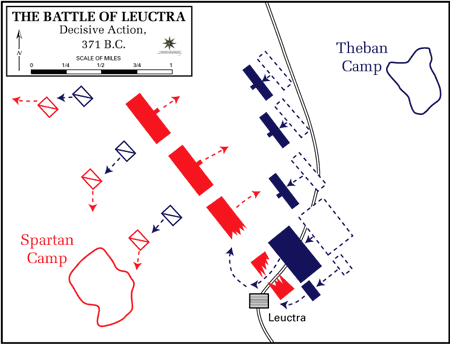.

|
Battle of Leuctra |
||
|---|---|---|
|
Conflict |
Post-Peloponnesian War conflicts |
|
|
Date |
371 BC |
|
|
Place |
||
|
Result |
Theban victory |
|
|
Combatants |
||
|
Commanders |
||
|
Strength |
||
|
About 6000 |
About 10 000 |
|
|
Casualties |
||
|
Unknown |
About 2000 |
|
|
Greek Wars of the 4th century BC
|
||
Leuctra was a village of Boeotia in the territory of Thespiae, chiefly noticeable for the battle fought in its neighborhood in 371 BC between the Thebans and the Spartans and their allies.
At the beginning of the 4th Century B.C., the cities of Thebes and Sparta were engaged in a political feud and sporadic warfare as the Spartans sought to maintain their position as the predominant Greek city-state while the Thebans struggled to expand their own influence. One of the principle issues between the two powers involved the region of Boeotia, which was under the political influence of Thebes. The dispute came to a head when a coalition of Boeotian city-states appealed to Sparta to free them from Theban political control. The Spartans demanded that the Thebans disband their army of occupation. The Thebans refused, and so the Spartan King Cleombrotus I marched to war from Phocis. Rather than take the expected, easy route into Boeotia through the usual defile, the Spartans marched over the hills via Thisbae and took the fortress of Creusis (along with twelve Theban warships) before the Thebans were aware of their presence. It was here that a Peloponnesian army, about 10,000–11,000 strong, which had invaded Boeotia from Phocis, was confronted by a Boeotian levy of perhaps 6,000–7,000 soldiers under Epaminondas. In spite of inferior numbers and the doubtful loyalty of his Boeotian allies, Epaminondas offered battle on the plain before the town.
Battle
The battle opened with the Spartan's mercenary peltasts (slingers, javilineers and/or skirmishers) attacking and driving back the Boeotian camp followers and others who were reluctant to fight. There followed a cavalry engagement, in which the Thebans drove their enemies off the field. Initially, the Spartan infantry were sent into disarray when their retreating cavalry hopelessly disrupted Cleombrotus's attempt to outflank the Theban phalanx, and were themselves caught on their flank by Pelopidas and the Sacred Band of Thebes. The decisive issue was then fought out between the Theban and Spartan foot.
The normal practice of the Spartans (and, indeed, the Greeks generally) was to establish their heavily armed infantry in a solid mass, or phalanx, some eight to twelve men deep. This was considered to allow for the best balance between depth (and the pushing power it provided) and width (i.e., area of coverage of the phalanx's front battle line). The infantry would advance together so that the attack flowed unbroken against their enemy. In order to combat the phalanx's infamous right-hand drift (see article phalanx for further information), Greek commanders traditionally placed their most experienced, highly regarded and, generally, deadliest troops on the right wing. By contrast, the shakiest and/or least influential troops were often placed on the left wing.
In a major break with tradition, Epaminondas massed his cavalry and a fifty-deep column of Theban infantry on his left wing, and sent forward this body against the Spartan right. His shallower and weaker center and right wing columns were drawn up so that they were progressively further to the right and rear of the proceeding column, in the so-called Echelon formation. The footsoldiers engaged, and the Spartans' twelve-deep formation on their right wing could not sustain the heavy impact of their opponents' 50-deep column. The Spartan right was hurled back with a loss of about 1,000 men, of whom 400 were Spartan citizens, including the king Cleombrotus I. By the time the Theban center and right columns advanced to the point of engaging the enemy, the Spartan right had been devastated. Seeing their right wing beaten, the rest of the Peloponnesians, who were essentially unwilling participants, retired and left the enemy in possession of the field. The arrival of a Thessalian army under Jason of Pherae persuaded a relieving Spartan force under Archidamus not to heap folly on folly and to withdraw instead, while the Thebans were persuaded not to continue the attack on the surviving Spartans.

The Battle of Leuctra, Initial Situation

Decisive Action (http://www.dean.usma.edu)
Seeing their right wing beaten, the rest of the Peloponnesians (unwilling participants) retired and left the enemy in possession of the field. The arrival of a Thessalian army under Jason of Pherae persuaded a relieving Spartan force under Archidamus not to heap folly on folly and to withdraw instead, while the Thebans were persuaded not to continue the attack on the surviving Spartans. But the battle is none the less of great significance in Greek history. It marks a revolution in military tactics, affording the first known instance of a deliberate concentration of attack upon the vital point of the enemy's line. Its political effects were equally far-reaching: The loss in material strength and prestige which the Spartans here sustained went part of the way in depriving them forever of their supremacy in Greece.
Historical Significance
The battle is of great significance in Greek history, and, by extension, world history. Epaminondas not only broke away from the traditional tactical methods of his time, but marked a revolution in military tactics, affording the first known instance of an oblique infantry deployment and one of the first deliberate concentrations of attack upon the vital point of the enemy's line. The new tactics of the phalanx, introduced by Epaminondas, employed for the first time in the history of war the modern principle of local superiority of force.
The use of these tactics by Epaminondas was, perhaps, a direct result of the use of some similar maneuvers by Pagondas, his countryman, during the Battle of Delium. Further, Philip of Macedon, who studied and lived in Thebes, was no doubt heavily influenced by the battle to develop his own, highly effective approach to tactics and armament. In turn, his son Alexander would go on to develop his father's theories to an entirely new level.
Historians Victor Davis Hanson and Donald Kagan, among others, have argued that Epaminondas's so-called "oblique formation" was not an intentional and preconceived innovation in infantry tactics, but was rather a clever response to circumstances. Because Epaminondas had stacked his right side to a depth of fifty shields, the rest of his units were naturally left with far fewer troops than normal. This means that their maintenance of a depth of eight to twelve shields had to come at the expense of either number of companies or their width. Because Epaminondas was already outnumbered, he had no choice but to form fewer companies and march them diagonally toward the much longer Spartan line in order to engage as much of it as possible. Hanson and Kagan's argument is therefore that the tactic was more dilatory than anything else. Whatever its motivation, the fact remains that the tactic did represent an innovation and was undoubtedly highly effective.
The battle's political effects were far-reaching: The losses in material strength and prestige (prestige being an inestimably important factor in the Peloponnesian War) sustained by the Spartans at Leuctra and subsequently at the Battle of Mantinea were key in depriving them forever of their supremacy in Greece. Therefore, the battle permanently altered the Greek balance of power, as Sparta was deprived of her former prominence and was reduced to a second-rate power among the Greek city states.
| Ancient Greece
Science, Technology , Medicine , Warfare, , Biographies , Life , Cities/Places/Maps , Arts , Literature , Philosophy ,Olympics, Mythology , History , Images Medieval Greece / Byzantine Empire Science, Technology, Arts, , Warfare , Literature, Biographies, Icons, History Modern Greece Cities, Islands, Regions, Fauna/Flora ,Biographies , History , Warfare, Science/Technology, Literature, Music , Arts , Film/Actors , Sport , Fashion --- |
Retrieved from "http://en.wikipedia.org"
All text is available under the terms of the GNU Free Documentation License

